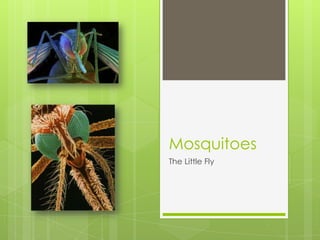
Mosquitoes
- 1. Mosquitoes The Little Fly
- 2. Notes All contents have references listed at the end of this presentation. All images are linked to their original webpage. Some slides have notes for more explanation. Please check at the “Notes” tab below this window.
- 3. Mosquitoes A common insect in the family Culicidae(midge or gnat). 150 million years ago: the oldest known type of mosquito. 90 million years ago: The oldest known mosquito with similar features as the modern mosquitoes. An adult mosquito is about 1 inch long.
- 4. Types of Mosquitoes There are more than 3,500 species of mosquito worldwide. Of human importance are: Aedes Anopheles Culex Aedes Anopheles Culex
- 6. Breeding Areas Mosquitoes will practically breed anywhere where there is a collection of water that stands longer than five to seven days. Some prefer lighted areas and some shady areas. Some prefer fresh water and some stagnant water. Common man-made breeding areas: Wells and Cisterns Rain barrels, cans, buckets Roof gutters Drains, Septic tanks, cesspools Road holes, road gutters Discarded old tires Common natural breeding areas: Ponds Pools Slow-moving streams Swamps and bogs Ditches Tree holes Rock holes
- 7. Life Cycle
- 8. Target cues Mosquitoes use visual, chemical, and heat cues to target their blood hosts, here are some specific cues: Dark-colored clothing Movement Alcohol Genetics – 85% Chemicals: carbon dioxide, lactic acid, octenol, steroids, uric acid and cholesterol on skin. Pregnancy Body temperature
- 9. Food and Blood A study in 1977 reported that an amino acid, isoleucine, is important for egg production. There is a positive correlation between the level of isoleucine in blood and the number of eggs produced. Female mosquitoes use blood for their gonotrophic cycle, i.e. feeding, convert blood to egg meal, and lay eggs An average blood meal is about 2 microliters.
- 10. References Characteristics of Anopheles, Aedes, and Culex mosquitoes. “How mosquitoes work,” by Dr. Craig Freundenrich “Why do mosquitoes bite some people more than others?” by Meredith Knight “Mosquito’s life cycle.”Westchestergov.com
- 11. “Are You a Mosquito Magnet?” by Elizabeth Heubeck. Mosquito movies by Rutgers’ Center for Vector Biology. “Differential utilization of blood meal Amino Acids in mosquitoes.” by Zhou and Miesfield, September 2009. “Why do mosquitoes need our blood?” Beyond Biology.
- 12. “1-octen-3-ol,” Wikipedia. “Chemical properties of attractants,” Catching tsetse.
Hinweis der Redaktion
- The Anopheles mosquito is the primary vector for malaria.The Aedes mosquito is the vector for dengue fever, yellow fever, encephalitis, and others.The Culex mosquito serves as vector for the West Nile virus, filariasis, Japanese encephalitis, St. Louis encephalitis, and avian malaria.
- The first view depicts the mosquito in the act of drinking blood, note the blood in its proboscis.The second view gives the detailed parts such as the head, thorax, abdomen, wings, forelegs, abdomen, mid and hind legs.
- Looking at this list, there are many ways that mosquitoes can live and breed. It would be nearly impossible for us to totally control large areas, therefore, awareness of where mosquitoes breed in the community especially around the house and neighboring houses is important for everyone.
- The mosquito’s life cycle consist of four stages: egg, larva, pupa and adult. Female mosquitoes lay hundreds of eggs after a blood meal and lay them on water. Within 1 to 2 days, the eggs hatch releasing larvae or “wigglers.” Anopheles’ larvae (singular, larva) position themselves in parallel with the water’s surface while Aedes’ and Culex’s position themselves vertically or in an angle. After 7 to 10 days post-egg hatch, the larvae become pupae (singular, pupa) then later as adult mosquitoes. Before flying, adult mosquitoes must stand on still water for a few minutes to dry their wings. This is why mosquitoes can’t breed in moving water.
- There are other ways people get easily bitten by mosquitoes:Genetics account for 85% of our susceptibility to mosquito bites. But how does genetic susceptibility to mosquito work? There are, as of now, no explanations yet.People who secrete large amounts of chemical markers such as cholesterol, steroids, and uric acid on their skin are prone for bites.Dark materials like clothing and plastic bags are good places where mosquitoes live, hide, and wait for targets.Carbon dioxide from our respiratory system and lactic acid from the skin are good chemical cues for mosquitoes. For a mosquito, this means a live target.Pregnant women are also at risk because of greater amounts of carbon dioxide that is excreted from their body.Octenol or 1-octen-3-ol is a colorless liquid with a strong smell of mushroom and a mosquito attractant. It is found in the breath and skin of humans. Its odor is described as green, moldy, or meaty. It is used as perfume and as a food additive.
